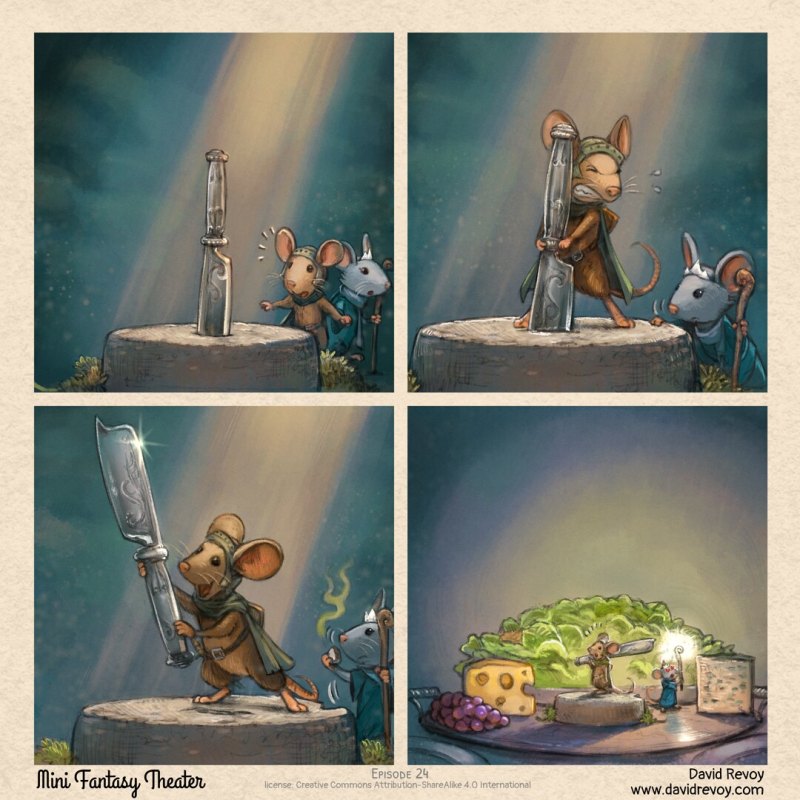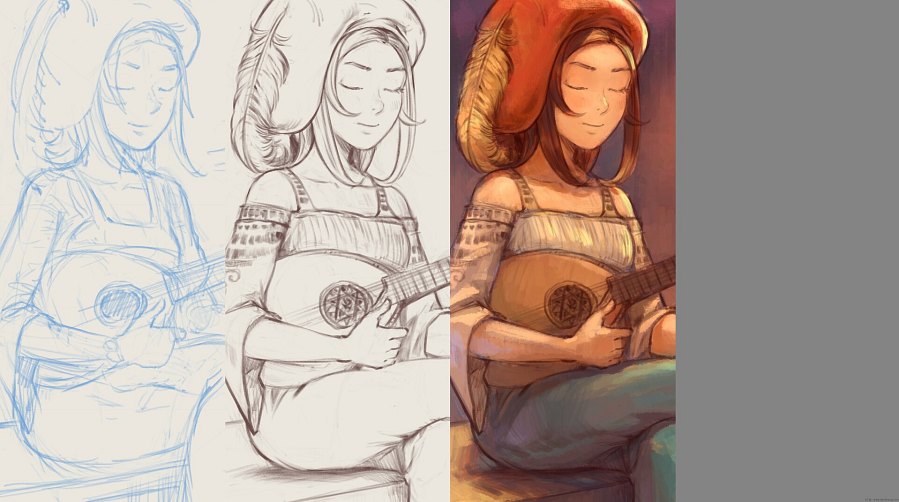
Recap of main events since episode 38:
A lot has happened since the release of the
last episode 38: 'The Healer'
in April 2023:
The canceled Episode 39 "The Bedtime Story"
After episode 38, the production of the episode 39 started in July 2023 and I posted a bit later
some concept-art
. By the end of 2023, I had a
version fully ready to read for the proofreaders
. The concept of this episode in a nutshell: Cayenne decided to use a bedtime story moment to info-dump the backstory of the series onto Pepper. In short, it was a ten page long flashback, with a lot of text and illustrations. The feedbacks I received at the Beta version taught me this episode rised more questions than answering ones, and its execution was clumsy. I tried to fix it for months, until I decided to give-up and restart from scratch in March 2024. As a post mortem, I backported in April 2025 some panels of this version to the
Timeline's Wiki page of Pepper&Carrot
. At least, not all of the hundreds and hundreds of hours put into this were totally a waste.
"The end of Pepper&Carrot", a blog-post I regret...
In mid 2024, after cancelling Episode 39 "The Bedtime Story", and following a long period of personal struggle and feeling down, I announced
the end of Pepper&Carrot
.
That was a mistake
. I wish I never published that blog-post. But the idea circulated well, way faster than the other blog-posts saying I wanted to continue the series. So, just to be clear: I'm continuing Pepper&Carrot series, I love it too much. I just had a very bad time.
The weekly MiniFantasyTheater comic-strips
During my long period of personal struggle and also discouraged by the extremely slow progress on Pepper&Carrot episodes and facing months without being able to post comics, I created a new comic project:
MiniFantasyTheater
. Short, quick, direct, and without all the technical debt of a 10 years old FLOSS project. It quickly felt great to post and interact on my social networks regularly, and it became a habit. But I also missed being able to write longer episodes. It took me some time to accept a paradox: I need to produce the two formats.
Refactor and new website
During all autumn and winter 2024, I paused the MiniFantasyTheater comic strip and decided to refactor and fix many technical debt I accumulated. I financed that on my own saving and doing Freelancer work. I incorporated many innovations I made for MiniFantasyTheater into Pepper&Carrot. The result of this big cleaning: the projects share now the same fonts, translation system, Git repositories, and
a new Pepper&Carrot website
, also technically, the project is now ready to scale up.
Money, support and financial situation
Neither my Patreon nor my Tipeee account has paid out since April 2023, as no new episodes of Pepper & Carrot have been released. It's my fault: when I started the project, I chose the "per content" support model instead of the "monthly subscription" model. This made sense back then when the project was short Pepper & Carrot episodes without maintenance, technical debt and larger and larger episodes. But right now, it has become problematic. There aren't many ways to support my weekly short comic format, except direct donations and Liberapay. To make matters worse, I also had to stop taking on freelance commissions, which had kept me afloat, because I needed more time to produce the MiniFantasyTheater episodes. However, Episode 39 is now well underway, and its release should help me a lot. After its release, I'll make more changes to this side of things and move to a monthly subscription support model. Of course, I'll notify supporters in advance so they can prepare.
Production conditions are tougher than ever
-
AI generative imagery:
It's everywhere and it drains me a lot of energy when I receive comments that my style looks like AI (almost weekly).
-
Linux is in its worst shape:
It's really difficult to advocate professional Digital Painting nowadays because of some massive bugs and regressions. Users are lost, it doesn't work, and with "the end of Windows 10", I get daily request about it. I published
a detailed install guide
to address this.
-
Tougher Society:
Inflation, hatred, wars, and the rise of fascism.
-
Family:
There have been way too many deaths...
Workflow research and development
Since the beginning of 2025, I have been (re)testing various workflows. The focus of this research was to find a method that I could replicate on dozens of panels consistently and enjoyably.
Workflow A: the classic
This is the classic of classics in the industry: line art, flat colors, and shading. This is the workflow I used for the first eight MiniFantasyTheater episodes. The problem? Once I obtained clean line art, I spent a lot of energy filling the artwork with color while preserving the line art's precision. So, coloring and shading became tedious and boring tasks. I always die a little inside while doing it because it doesn't stimulate my brain enough.

The three steps of the classic workflow on Shichimi and Torreya artwork.
Workflow B: direct painting
This is a workflow that I used a lot during my career as a concept artist. First, I built the grayscale building blocks, then recolored them approximately, and finally painted over them until they looked good. While this method is the fastest, hands down, it also has a major issue: many things can go wrong with the proportions, drawing of the face, and facial expressions. The same goes for speedlines or a specific perspective and view angle. All the efforts are postponed to the final pass, where I redraw the details and make everything solid. In this demo artwork, I did well, but unfortunately, for many panels in a comic, this method is simply hard to manage, pushing all the efforts toward the end of production.

Three steps of the direct painting workflow on Pepper 'Rain' artwork.
Workflow C: compromise
For episode 39, I've decided on a compromise workflow. First, I'm creating a thick sketch in mid-gray on a white background. This step is a bit frustrating because I can't make all the details look as precise as line art, but the goal is different. The goal is to create solid volumes that are correctly proportioned and to achieve the correct view angle and perspective. The pre-coloring step is divided into two steps: grayscale and recoloring the grayscale. I find it easier to focus on defining how the light source builds up the volume and splitting the different parts of the picture into grayscale. Thanks to the semi-transparent sketch, I have a guide that helps me minimize the number of brushstrokes. This makes them more visible, even once recolored, as individual entities rather than blending them together into a mess. Because of the thick sketch, it's also easier to paint in grayscale and recolor with precision. It's "blocky." Finally, I can flatten everything and selectively repaint or edit details on top.

Four steps of the workflow c, on the 'A Drink Alone' artwork.
If you look on a close-up you'll get a better idea of how the sketch totally blended into the final result, how the brush work is visible, and how the details and resolution are located only on few area of the painting. On this crop: the lips.

A close-up of the artwork "A Drink Alone".
Preproduction:
This section lists all the steps before drawing on the comic page, i.e., production.
Scenario
I wrote many scenarios, for which I mostly used Kate, the KDE Plasma desktop's text editor, to save my text files in Markdown format. Everything was versioned into Git repositories, but each time I wanted to open and refer to a version quickly, I saved the file incrementally. So, for each story, I ended up with a column that looked like the one on the left in the screenshot below. Thanks to Markdown, I can use the quoting symbol at the start of a sentence to get a different color for the dialogue. Sometimes, I want to reread only the dialogue, and it's convenient to have it color-coded.

A screenshot of Kate.
Here's a tip for determining the number of panels: In Kate, use the Regex search/replace function with the following:
^([A-Z])
, It will only count the first capital letter of a sentence. In my case, it will count the first letter of a new panel description.
Of course, I don't write my story panel by panel in this way, as you can see in the screenshot. This is the final product, the last cut, of many underlying passes.
Synopsis
My method often starts with a clumsy synopsis of a philosophical problem that I personally want to address and share with others. In future episode 39, the topic will be noise in public spaces and confronting strangers about it. It's a common problem we've all experienced: sharing a train, bus, or bar with strangers. Then, I write a long paragraph that broadly tells the story I have in mind, which I'll use as a metaphor: it will take place in a tavern with a group of warriors. There will be a minotaur, a hyena, and a lizard.
The Grid
Once I've written my synopsis (and I write many!), I test my favorite ones using what I call "the grid." It's a list of questions that helps me clarify the story's objective.
-
The universal problem of the episode.
-
The psychological blindspot preventing the main character from solving the issue.
-
The character's inner, strong desire.
-
The false idea the character has to solve the problem.
-
The immoral actions the main character is willing to commit to solve the problem.
-
The main character's real psychological need, which he does not see at the start but will grow to adopt.
-
A "revelation, turning point, or thought outside the box" that reveals the real need.
-
Unexpected twist(s).
-
Intrinsic human values of the story.
-
Visual interest and concept art.
Once the grid is completely filled in to my satisfaction, I move on to two things.
The Premise
The core of the story in one or two sentences: This will be my compass for the full episode.
Pepper, without her usual powers, learns the meaning of bravery. It is not the absence of fear, but rather the determination to act in spite of it.
The Beatsheet
This is a simplified version of the story in the form of a bullet list of simple actions. There is no dialogue or description. However, this structure respects the timeline of the final script. Below is a sample of how my beatsheet begins for episode 39.
-
Pepper and Cayenne stop in a village to rest and relax.
-
At night, the tavern is calm and peaceful.
-
But the atmosphere is quickly disrupted by a group of noisy, badly behaved warriors.
-
Cayenne discusses with Pepper how to tell the warriors that they are not alone.
The Cut
Once the beatsheet is complete, I copy and paste it into a new document. Then, I replace each line of the beatsheet with a panel description and dialogue. This process often requires many proofreading passes and corrections. Some panels can be removed, while others need to be inserted. Once the episode is correctly cut, however, we have a document to move on to the drawing part.
Concept art
For this episode, I decided not to create too many concept art for the visuals. My workflow is flexible enough that I don't need definitive line art with all the details from the beginning. I can create concept art of the new character I need and incorporate it as needed. However, some locations required more work. For example, here is a sketch of the exterior of the tavern hotel.

A drawing in grayscale of the exterior of the tavern.
I conducted more advanced research on the three warriors. Initially, I wanted characters that looked annoying, so I gave them the faces of well-known CEOs. However, that would have distracted from the main plot of the story, so I abandoned that idea.

A concept art exploration for the design of the warriors.

The three warriors: the minotaur, hyena and lizard on a panel.
Production
Storyboard
This time, I decided not to create lots of small thumbnails of each page in a single document as I often do, but to sketch directly on each Krita file pages. I wanted more control over the composition and placement of the dialogue, as well as over the zoom of each face and expression. I ended up storyboarding directly with a thin brush preset at low opacity. At this stage, I estimate the perspective, but I sometimes use a composition grid (e.g. for the 'thirds' rule, diagonals and centres). These sketches are quick to draw, which allows me to experiment with different angles and expressions until the scene is just right.
I also spent a long time feeling totally lost about the panel density. How many panels per page feel right? Is it different for a dialogue scene? Or an action scene? In the end, I collected and analysed hundreds of comic pages that I found online. I noted what felt like too many panels, what felt like a waste of a page, and what felt good or bad depending on the situation. This helped me pace my panels more consciously, rather than going by "feel" as I had done until then.

A sample without text of three panel at the storyboard step.
Sketching
I then drew over the storyboard with a flat brush and pressure-sensitive opacity I like how it feels like penciling. It's probably because of the mid-gray color over white. Many panels required a bit more preparation; for example, I used a perspective grid for almost all the panels in the montage at the beginning (illustration under) when Cayenne and Pepper arrive in a cute mountain village for the night. Because this scene was a montage, I saw that I could crank up the density. Seven panels for a comic page, it's rare for Pepper&Carrot.

The final drawing of the page 2 of future episode 39 "The Tavern".
Inking
I really dislike this step. It's something I have been fighting against since the beginning of the Pepper&Carrot project. In the first part of this article, I study various workflows to try and bypass this step. Unfortunately, I failed: after the first colouring test on my sketches, I realised that they were not clean enough and that I would need to carry out a lot of post-painting processes to clean everything up if I went down that route. In the end, I decided to redraw and ink all eleven pages. To give you an idea of the impact in terms of production time, it takes a minimum of 8 hours per page, for a total of 88 hours. It took me a little over a month to complete this step. In terms of technique, I used the c2) Mechanical Pencil Details brush preset at 18px, with no stabiliser, on the XPPen Artist Pro 19 (Gen2). I converted my sketches to blue, reduced their opacity, and used a deep red on a pale sand-coloured background to add a touch of colour and to make it easier to place the borderless speech bubbles and panel frames.
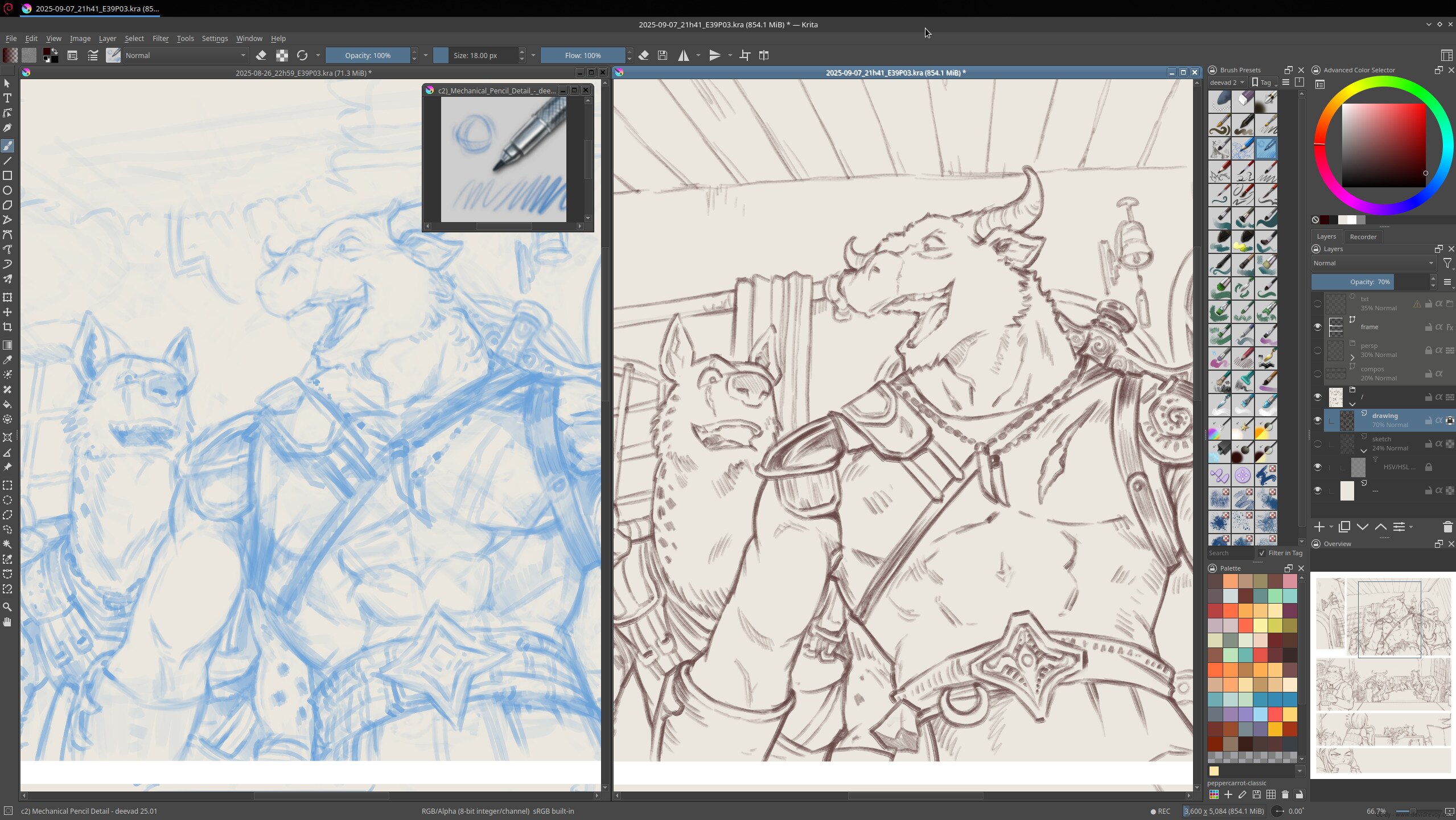
A side by side: final sketching, and final inking.
Proofreading
After the inking was done, I re-entered all the dialogue on Inkscape because, so far they were still part of the Krita files, and drew all the speechbubbles with vectors. Something relatively quick as it can be done on roughly four days. Then I setup
the collaborative thread for the proofreaders
on our Framagit to give me feedback on this first version, and help me with proofreading my English dialogues.
I was very afraid of this step. My experience with the cancelled episode 39, 'The Bedtime Story' (read the recap in the introduction for more details), made me anxious when I posted it. Fortunately, everything went alright: I collected many interesting feedback, and help.
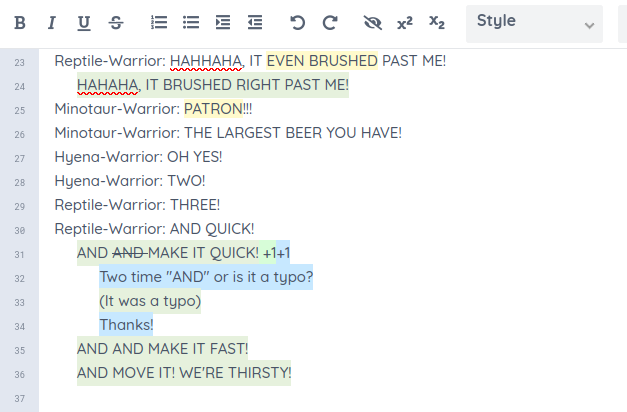
A screenshot of the colaborative pad for proofreading.
Color-sketch
For the coloring process, I decided to embrace a simple approach. I create a flat paint layer named "under" beneath my inking, and then I simply paint instinctively. I don't follow the classic "flat," then "shading" method. I just paint however I feel.
I discovered this while making the weekly comic strip. I had more fun distancing myself from realistic shading and just using pure colors. I also intentionally leave large brush crosshatching to avoid a "genAI" perfectly smooth and contrasted output. I try to find the sweet spot of "not perfect, but charming".
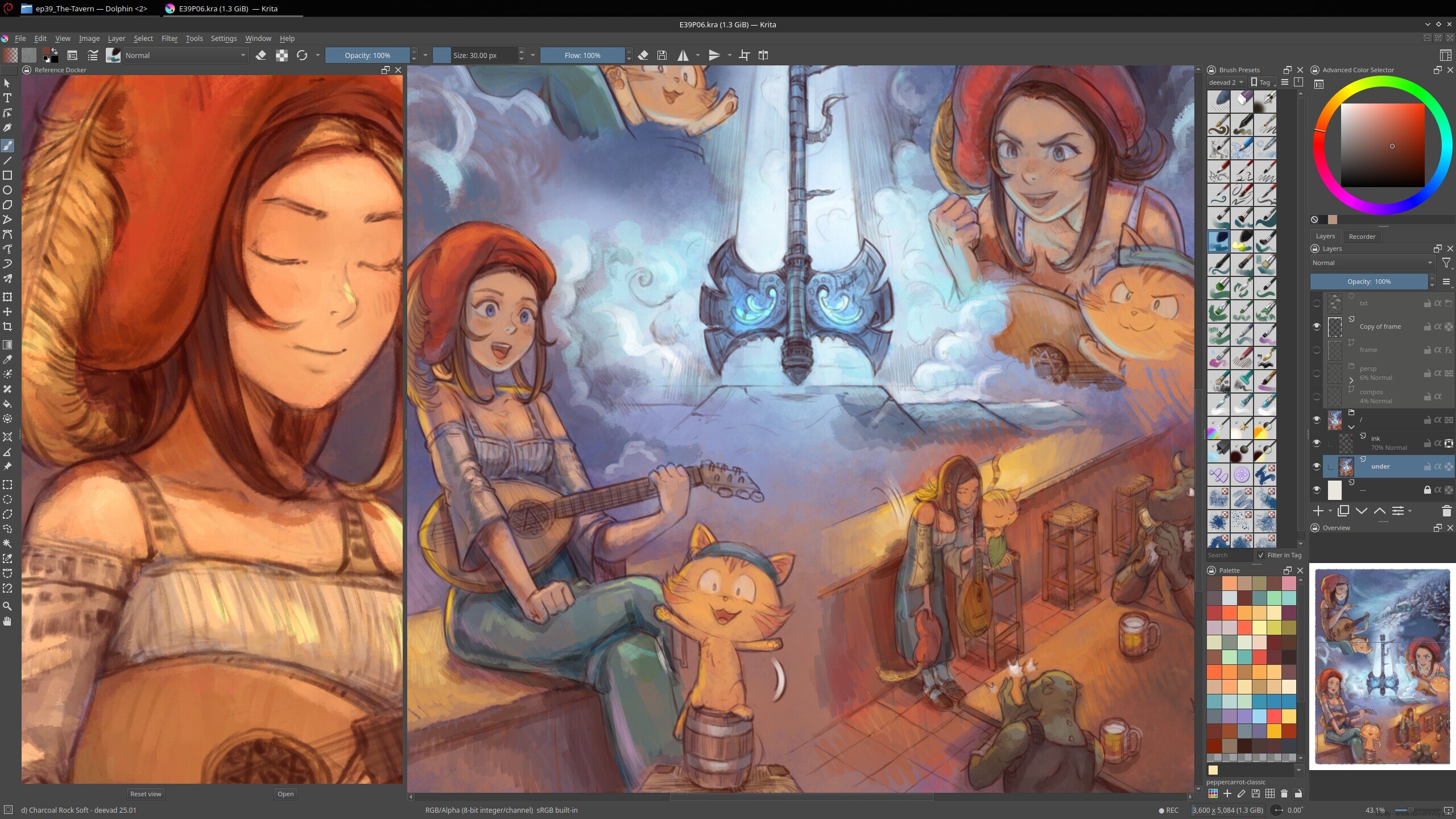
A screenshot while precoloring.
Technically, I mainly use the "Charcoal Rock Soft" brush preset. I keep the entire page visible on my screen and put the Krita
Reference docker plugin
on the left side to use my previous pages as a reference. I added the default Palette docker to my dockers with a small collection of my favorite colors because I realized I was repeatedly placing these tints.
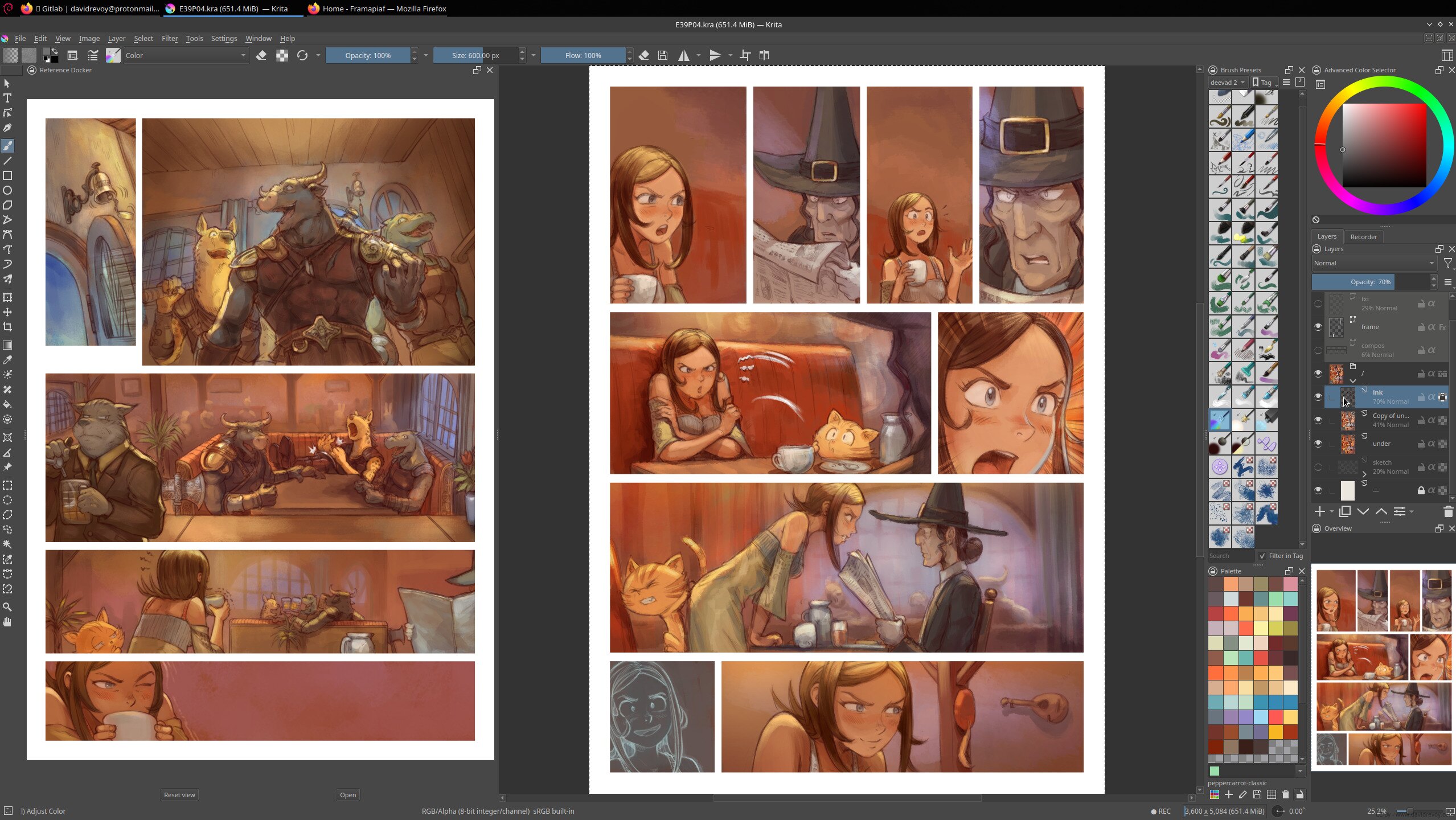
Another screenshot while precoloring.
Painting over the final touches
The final step is creating an "over" layer above the inking. I use a small brush to add more detail. I haven't started this step yet, except for one landscape, which I will share below.
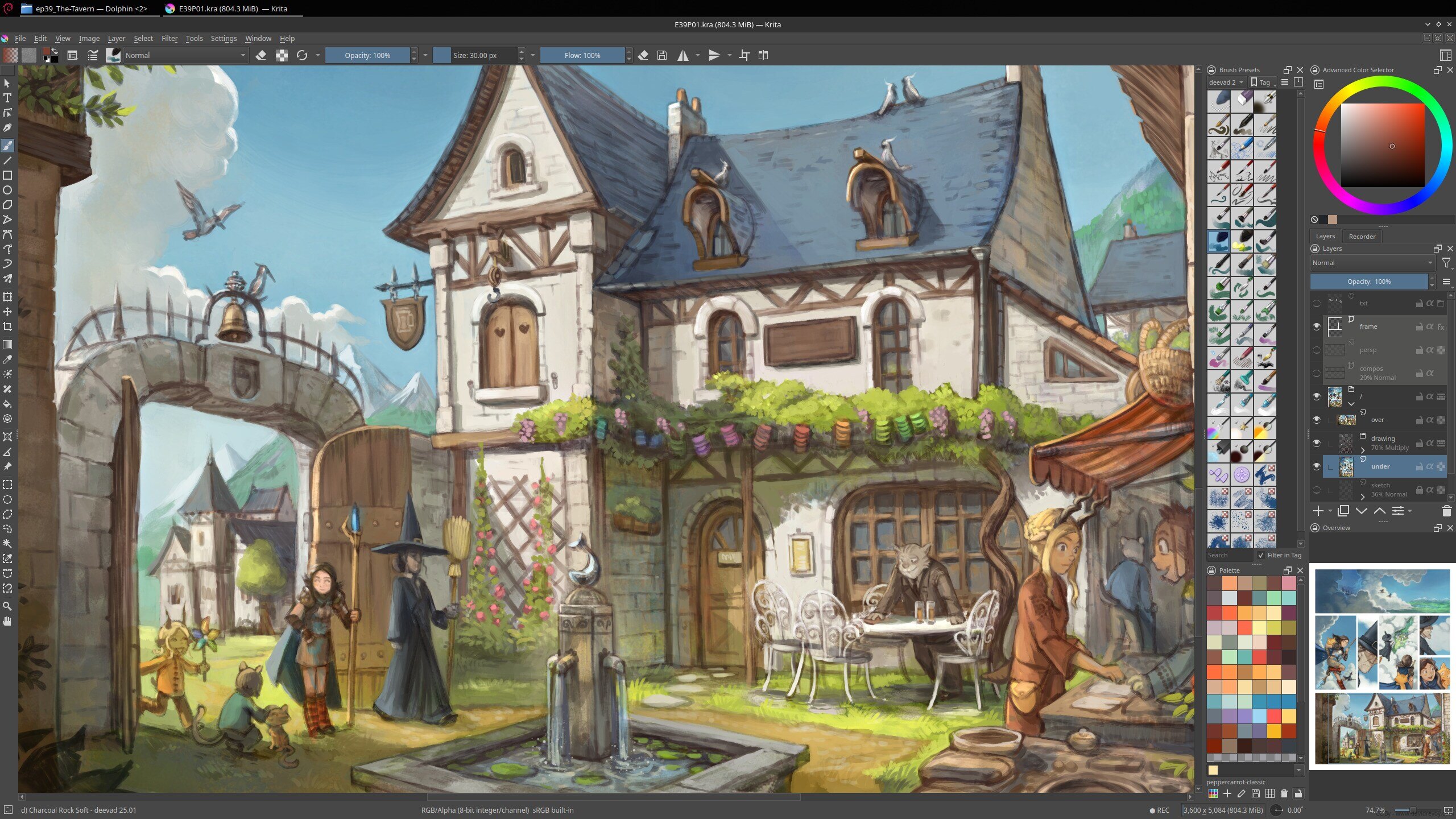
A screenshot of a detailed landscape.
Work in progress... (to be continued)
That's all for today. I'm still coloring the last pages of the next episode. Next, I'll compile all the proofreading feedback from the proofreading thread. Then, I'll submit a "beta 2" version for a final proofreading, which will be fully pre-colored. Once the English version is finalized, the French translation and other languages will begin. In the meantime, I'll continue detailing every page.
Do I have a deadline in mind for the release? Yes, I hope to finish the last hundred hours of work necessary for mid-November.
The challenge continues!
Want to read previous production reports? They are all now
here under the #making-of tag
and comments of the first part for this article are
here
.
























